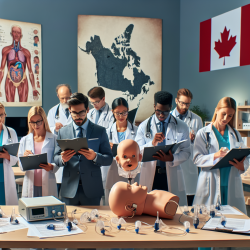Introduction
In the field of speech-language pathology, making informed decisions based on data is crucial for enhancing therapeutic outcomes. A recent study titled "Enhanced weathering as a trigger for the rise of atmospheric O2 level from the late Ediacaran to the early Cambrian" provides insights that can be metaphorically applied to our practice. By examining the mechanisms of atmospheric changes and their impact on life forms, we can draw parallels to how data-driven decisions can enhance outcomes in speech-language therapy.
Understanding Enhanced Weathering
The study by Li et al. (2019) explores how enhanced weathering during the Ediacaran-Cambrian transition led to a significant rise in atmospheric oxygen levels, which in turn supported the development of complex life forms. This process involved the chemical breakdown of rocks, releasing nutrients that fueled biological growth. The research highlights the importance of environmental changes in shaping biological evolution, a concept that can be applied to the evolution of therapeutic practices in speech-language pathology.
Applying Data-Driven Decisions in Therapy
Just as enhanced weathering provided the necessary conditions for the Cambrian explosion, data-driven decisions in speech-language pathology create the optimal environment for therapeutic success. Here are some ways practitioners can implement data-driven approaches:
- Assessment and Diagnosis: Utilize comprehensive assessments to gather quantitative data on a child's speech and language abilities. This data serves as a baseline to track progress and tailor interventions.
- Evidence-Based Interventions: Choose interventions backed by empirical evidence. Research, much like the study on enhanced weathering, provides a foundation for selecting effective strategies.
- Progress Monitoring: Regularly collect data on a child's progress to adjust interventions as needed. This iterative process ensures that therapy remains aligned with the child's evolving needs.
- Outcome Measurement: Use standardized measures to evaluate the effectiveness of interventions. This approach mirrors the scientific rigor of measuring atmospheric changes in the study.
Encouraging Further Research
The study on enhanced weathering underscores the value of ongoing research in understanding complex systems. Similarly, speech-language pathologists should engage in continuous professional development and research to stay abreast of new findings and methodologies. By fostering a culture of inquiry, practitioners can contribute to the advancement of the field and improve outcomes for children.
Conclusion
The concept of enhanced weathering and its impact on atmospheric oxygen levels provides a powerful metaphor for the role of data-driven decisions in speech-language pathology. By embracing evidence-based practices and continuous research, practitioners can create an environment that fosters the development of children's communication skills. To delve deeper into the original research, please follow this link: Enhanced weathering as a trigger for the rise of atmospheric O2 level from the late Ediacaran to the early Cambrian.










